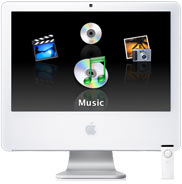2007 — 18 Feb: time for a change of PC philosophy
Now I've been and gone and quite possibly done it: I've ordered a 24" Apple iMac. What's the world coming to? A grinding halt, I suspect, in this
small corner while I get used to the cultural shock.

I wonder, though, whether it will be as severe a jolt as all that after my decade plus happily spent looking down on, and sneering at, Microsoft-driven PCs from the comfort and luxury of the Acorn RISC world.1 Mind you, my first foray into home PCs came quite late, back in 1985, with an Amstrad2 PCW256 word processing system (anyone else remember the amazingly capable LocoScript?) — one of the first 14 sold by Dixons in Southampton. That one paid for itself very quickly when I was sub-contracted to work on a series of defence-industry oriented patent abstracts for my friend Hugh in his post-Haymarket magazine editor days.
4 MHz ARM2
I moved into the Acorn world in 1989 as a happy innocent with a £3,800 4MB A440 (think 14x the speed of the original IBM PC in 1981) with a 20MB disk and dot matrix printer all paid for by IBM.3 This had a perfectly adequate word processing system (anyone remember 1stWordPlus?) and the process of file exchange between Acorn and IBM was much helped by one of my young colleagues who, when not teaching karate, could work the necessary command-line incantations that did the magic between the Acorn's 1.6MB ADFS format diskettes and good ol' 1.44MB Microsoft DOS format on an OS/2 machine and on to the LAN we had at the time. However, though the Acorn offered an entry level DTP capability, my real (but unrevealed) motivation had actually been to get my mitts on a wonderful visual interface relational database "card index" system (anyone remember System DeltaPlus?) for tracking the odd book, video, and bit of music. I was not the only Acorn RISC enthusiast in the IBM laboratory, by the way...
25 MHz ARM3
The A440 lasted me well and I naturally rewarded it by giving it an 84MB SCSI disk, a 25MHz ARM3 processor (with an enormous 4KB cache, I believe) and a laser printer driven via a so-called video interface (anyone remember LaserDirect?) that squeezed 600 dpi and 4 ppm out of a basic Canon print engine by some very clever interpolation. The system, of course, blew spots off the Amstrad CP/M z80 system from Day 1. But, as PCs and dogs always do, it died on me. This was in 1993 just as I once again needed a home PC "for real work". Hence its hastily-ordered replacement, an 8MB A5000 with about 150MB disk (happily also all paid for by IBM.4)
30 MHz? ARM7? 200 MHz, StrongARM!
This was all very well, but on a visit to the "local" Acorn store5 I checked out and then bought what was to be my final Acorn: a 32MB RISC-PC700 [paid for by me]. This I upgraded to 64MB and (in 1996) I also gave it a heart transplant with the new 200MHz StrongARM6 processor and various lumps of further disk, all of which was most reluctantly displaced in very late 2002 by a 512MB 2.5GHz Pentium of some sort [paid for by me] in an admittedly neat Shuttle case. Mind you, VirtualAcorn enabled me to emulate an A5000 (and therefore run all my software and retrieve all my data) at about 150% of the speed of the real thing. I guess, when you only have 16 instructions to handle, it's not that hard to write a good emulator. (Even on a PC.)
There's a new colour flatbed scanner on the way, too, as She has her eye on my existing one in aid of Her long-term documentation project. Plus, perhaps now is a good time to admit I've also got a "Slug" heading this way. I can't help but feel it will come in handy.
And in the spirit of full disclosure, but worlds away from computing, we're also replacing the 25-year-old (and extremely ugly) gas fire in our living room with a fancy new "plasma" model. Mr Power Flush (who has the all-important "Corgi ticket" certification) will be tackling that job for us, assuming B&Q manages to deliver7 it.
Hair today, gone tomorrow department
Such amazing stuff you learn on late-night BBC radio news bulletins. This is UK national news, remember, proudly bringing truth and beauty to the citizens in the tradition of Lord Reith. Well, in the bulletin I gather that a young lady named Britney Spears — one of the ladies with "waxed nether-regions" mentioned hair — has now shaved off all her hair (and not just the area that could be covered by a merkin and uncovered by paparazzi!) I'm uncertain who is the bigger air-head; the young lady in question, or the smart Media Studies graduate who thinks this constitutes "news".
News is what they don't want you to know. Everything else is advertising.